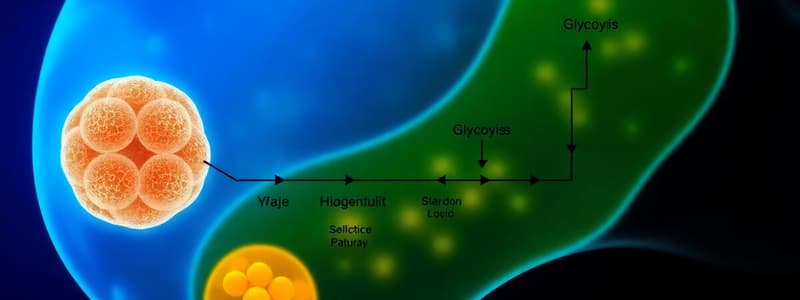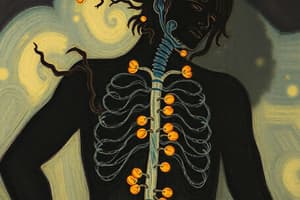Podcast
Questions and Answers
What is the primary function of glycolysis in cellular respiration?
What is the primary function of glycolysis in cellular respiration?
- To produce lactate in the presence of oxygen.
- To break down glucose into pyruvate. (correct)
- To convert glucose into ATP directly.
- To transfer pyruvate into fatty acids.
Which products result from the aerobic breakdown of pyruvate?
Which products result from the aerobic breakdown of pyruvate?
- Acetaldehyde and NADH.
- Glycogen and glucose.
- Carbon dioxide and ATP. (correct)
- Lactate and ATP.
How is ATP production coupled to glycolysis?
How is ATP production coupled to glycolysis?
- ATP is generated through fermentation during glycolysis.
- ATP is synthesized through oxidative phosphorylation.
- ATP is produced via substrate-level phosphorylation. (correct)
- ATP does not form during glycolysis.
What is the net gain of ATP during glycolysis when starting with one molecule of glucose?
What is the net gain of ATP during glycolysis when starting with one molecule of glucose?
In which phase of glycolysis does the preparatory phase occur?
In which phase of glycolysis does the preparatory phase occur?
Why is phosphorylated intermediates important in glycolysis?
Why is phosphorylated intermediates important in glycolysis?
What happens to pyruvate in anaerobic conditions?
What happens to pyruvate in anaerobic conditions?
Which type of respiration requires the presence of oxygen?
Which type of respiration requires the presence of oxygen?
Which enzyme catalyzes the conversion of glyceraldehyde 3-phosphate to 1,3-bisphosphoglycerate?
Which enzyme catalyzes the conversion of glyceraldehyde 3-phosphate to 1,3-bisphosphoglycerate?
What is produced when 1,3-bisphosphoglycerate is converted to 3-phosphoglycerate?
What is produced when 1,3-bisphosphoglycerate is converted to 3-phosphoglycerate?
What type of reaction occurs when 2-phosphoglycerate is dehydrated by enolase?
What type of reaction occurs when 2-phosphoglycerate is dehydrated by enolase?
During glycolysis, what is the fate of pyruvate under anaerobic conditions?
During glycolysis, what is the fate of pyruvate under anaerobic conditions?
Which statement is true regarding the reaction catalyzed by pyruvate kinase?
Which statement is true regarding the reaction catalyzed by pyruvate kinase?
What is the role of phosphoglycerate mutase in glycolysis?
What is the role of phosphoglycerate mutase in glycolysis?
Which substrate contributes to the formation of ATP during the conversion of 1,3-bisphosphoglycerate to 3-phosphoglycerate?
Which substrate contributes to the formation of ATP during the conversion of 1,3-bisphosphoglycerate to 3-phosphoglycerate?
What happens to NAD+ during the conversion of pyruvate to lactate?
What happens to NAD+ during the conversion of pyruvate to lactate?
What is the state of pyruvate kinase when it is inactive?
What is the state of pyruvate kinase when it is inactive?
Which phase of glycolysis involves the investment of ATP?
Which phase of glycolysis involves the investment of ATP?
How many ATP are formed from the oxidation of one triose phosphate during the payoff phase of glycolysis?
How many ATP are formed from the oxidation of one triose phosphate during the payoff phase of glycolysis?
Which enzymes are primarily regulated in the glycolytic pathway to maintain ATP levels?
Which enzymes are primarily regulated in the glycolytic pathway to maintain ATP levels?
What is the net result of glycolysis from one molecule of glucose?
What is the net result of glycolysis from one molecule of glucose?
What enzyme catalyzes the isomerization of glucose 6-phosphate to fructose 6-phosphate?
What enzyme catalyzes the isomerization of glucose 6-phosphate to fructose 6-phosphate?
Which statement accurately describes the phosphorylation of fructose 6-phosphate?
Which statement accurately describes the phosphorylation of fructose 6-phosphate?
What are the products of the cleavage of fructose 1,6-bisphosphate?
What are the products of the cleavage of fructose 1,6-bisphosphate?
What must happen to dihydroxyacetone phosphate for further metabolism in glycolysis?
What must happen to dihydroxyacetone phosphate for further metabolism in glycolysis?
Which statement about the ATP yield in glycolysis is correct?
Which statement about the ATP yield in glycolysis is correct?
During glycolysis, what does NAD+ convert into when it is reduced?
During glycolysis, what does NAD+ convert into when it is reduced?
Which enzyme is considered the most important control point in glycolysis?
Which enzyme is considered the most important control point in glycolysis?
What role does fructose 2,6-bisphosphate have in glycolysis?
What role does fructose 2,6-bisphosphate have in glycolysis?
What is the effect of H+ ions on phosphofructokinase (PFK)?
What is the effect of H+ ions on phosphofructokinase (PFK)?
How does fructose 2,6-bisphosphate (F-2,6-BP) affect PFK-1?
How does fructose 2,6-bisphosphate (F-2,6-BP) affect PFK-1?
What role does glucagon play in the regulation of PFK-2 and FBPase2?
What role does glucagon play in the regulation of PFK-2 and FBPase2?
What happens to hexokinase when PFK is inhibited?
What happens to hexokinase when PFK is inhibited?
What effect does insulin have on the activities of PFK-2 and FBPase2?
What effect does insulin have on the activities of PFK-2 and FBPase2?
What condition does excessive lactate formation relate to?
What condition does excessive lactate formation relate to?
Which of the following molecules can inhibit pyruvate kinase (PK)?
Which of the following molecules can inhibit pyruvate kinase (PK)?
What is the primary regulatory step unique to glycolysis?
What is the primary regulatory step unique to glycolysis?
Flashcards are hidden until you start studying
Study Notes
Cellular Respiration
- Is a set of metabolic reactions that take place in cells to convert chemical energy from oxygen molecules or nutrients into ATP.
- Consists of two types: Anaerobic and Aerobic
- Anaerobic respiration occurs in the absence of oxygen.
- Aerobic respiration requires oxygen to generate ATP.
Glycolysis
- Is a pathway used by all tissues for the breakdown of glucose.
- Glucose is metabolized to pyruvate.
- The breakdown of glucose into pyruvate occurs in ten steps:
- Preparatory Phase
- Payoff Phase
Preparatory Phase
- Five steps are involved in the preparatory phase.
- Glucose is converted to fructose 1,6-bisphosphate.
- Two ATP molecules are consumed in this phase.
Payoff Phase
- The remaining five steps constitute the payoff phase.
- Fructose 1,6-bisphosphate is broken down into two molecules of glyceraldehyde 3-phosphate.
- Oxidation of glyceraldehyde 3-phosphate generates NADH and two ATP molecules per triose phosphate.
Net Gain of ATP
- The net gain of ATP during glycolysis is two ATP molecules per glucose molecule.
NAD+ Role
- NAD+ is a key coenzyme in glycolysis.
- It picks up electrons during the oxidation of glyceraldehyde 3-phosphate, forming NADH.
- NADH is a reducing agent that can donate electrons to other molecules.
Regulation of Glycolysis
- Glycolysis is tightly regulated to ensure a steady supply of ATP.
- Key enzymes involved in regulation are Hexokinase, PFK-1, and Pyruvate Kinase.
PFK-1 Regulation
- PFK-1 is the most important control point of glycolysis.
- It is activated by fructose 2,6-bisphosphate.
- PFK-1 is also regulated by ATP and fructose 6-phosphate concentrations.
Hexokinase Regulation
- Hexokinase is inhibited by glucose 6-phosphate.
- It is also affected by the concentration of the reactant (glucose) and the availability of ATP.
Pyruvate Kinase Regulation
- Pyruvate Kinase is inhibited by ATP, long-chain fatty acyl CoA, and Acetyl CoA.
- It is also under hormonal regulation by Glucagon and Insulin.
- Insulin activates pyruvate kinase by dephosphorylating it.
- Glucagon inhibits pyruvate kinase by phosphorylating it.
Overall Summary of Glycolysis
- Glycolysis is a near-universal pathway for glucose breakdown to pyruvate.
- It generates ATP, NADH, and pyruvate.
- All ten glycolytic enzymes are located in the cytosol.
Importance of Glycolysis
- It is essential for energy production in all living organisms.
- It provides the starting material for other metabolic pathways like the citric acid cycle.
- It is a critical pathway in various cellular processes, including muscle contraction, nerve impulses, and biosynthesis.
Studying That Suits You
Use AI to generate personalized quizzes and flashcards to suit your learning preferences.




